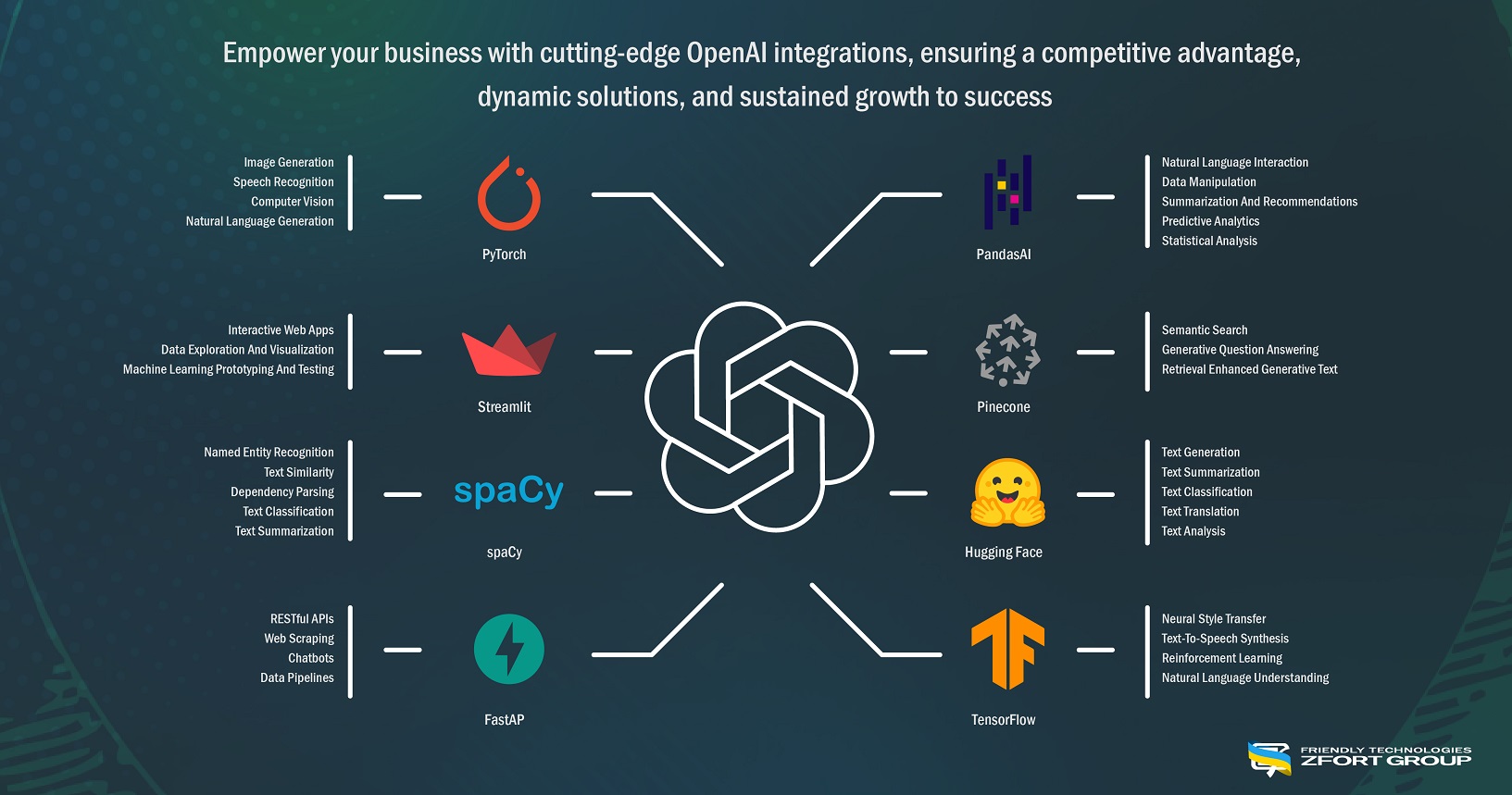This article will explore some of the tasks we can do by combining OpenAI with frameworks, libraries, and databases.
We will show how these combinations can leverage the strengths and advantages of each component and create synergies and innovations in AI.
Artificial intelligence (AI) is a rapidly evolving field with many applications and challenges.
One of the leading research organizations in AI is OpenAI, which aims to create and promote AI that can benefit humanity without causing harm or being misused.
OpenAI has developed various projects and achievements in natural language processing (NLP), computer vision, generative modeling, reinforcement learning, and more.
However, OpenAI is not the only player in the AI landscape. Many other frameworks, libraries, or databases offer different tools and features for AI development and deployment. It can complement and enhance the capabilities of OpenAI's APIs and models and enable new and exciting tasks and applications. Along with frameworks and databases, iPaaS can integrate OpenAI with other applications, providing a unified solution for handling data, automation, and workflows across multiple platforms.

OpenAI + PandasAI
PandasAI is an incredible Python library designed to make working with dataframes a breeze, offering a natural and conversational approach.
It harnesses the power of OpenAI's generative AI models to enable seamless data analysis and manipulation. With PandasAI, you can effortlessly perform tasks like filtering, sorting, grouping, aggregating, and even creating new columns or rows.
It doesn't stop there; PandasAI also assists in generating insights, charts, statistics, and more, all driven by simple, natural language queries.
The synergy between OpenAI and PandasAI brings several notable advantages:
- Natural Language Interaction: You can ask questions in plain language and receive informative responses, insights, and visualizations from AI models.
- Data Manipulation: Conduct data analysis and manipulation using conversational commands like filtering, sorting, grouping, and aggregating.
- Summarization and Recommendations: Generate concise, natural language summaries, explanations, or recommendations based on your data.
- Predictive Analytics: Forecast future trends and values by leveraging historical data, whether it's sales, demand, or customer behavior.
- Statistical Analysis: Perform hypothesis testing, correlation analysis, regression analysis, and inferential statistics to gain a deeper understanding of relationships between variables.
OpenAI + Pinecone
Conversely, Pinecone is a cloud-based service tailored for building scalable and lightning-fast vector search engines. These engines are adept at handling vector representations of data, including images, texts, sounds, and videos, allowing you to find the most relevant or similar items in response to a query. Pinecone's capabilities extend to semantic search, recommendation systems, image retrieval, and face recognition applications.
The collaboration of OpenAI and Pinecone opens up exciting possibilities:
- Semantic Search: Utilize OpenAI's embedding API to generate vector representations of natural language texts and then index and query these vectors in Pinecone, ensuring rapid and scalable semantic search.
Find texts that closely match your query in meaning, not just keywords. - Generative Question Answering: Combine Pinecone's ability to retrieve relevant contexts from a large corpus of documents with OpenAI's completion API to produce accurate, data-backed answers to your questions.
- Retrieval Enhanced Generative Text: Query relevant texts from Pinecone's extensive collection and then employ OpenAI's completion API to generate continuations or variations based on these texts, enhancing your creativity and diversity in text generation.
OpenAI + Hugging Face
Hugging Face, a company and community dedicated to NLP provides a wealth of tools and resources. NLP encompasses tasks such as understanding and generating natural language texts, whether it's articles, books, tweets, or chats. Hugging Face's mission centers around democratizing NLP and making it accessible to all.
The collaboration between OpenAI and Hugging Face promises several intriguing opportunities:
- Text Generation: Leverage OpenAI's completion API to generate natural language texts based on prompts, contexts, or styles.
Additionally, tap into Hugging Face's transformers library to fine-tune pre-trained models for your specific domains and needs. - Text Summarization: Use OpenAI's summarization API to create concise and informative summaries of lengthy texts, such as articles, documents, or books.
Access and process various text corpora for training and evaluation through Hugging Face's datasets library. - Text Classification: Employ OpenAI's classification API to assign labels or categories to texts, be it sentiment, topic, genre, or language.
Create and deploy interactive web apps for text classification tasks with Hugging Face's spaces platform. - Text Translation: Utilize OpenAI's translation API to seamlessly translate texts across different languages like English, French, Spanish, or German.
Explore and download diverse translation models from the community through Hugging Face's model hub. - Text Analysis: Harness OpenAI's analysis API to extract information and insights from texts, including entities, keywords, emotions, and tone. Experiment with and compare different text analysis models using Hugging Face's widgets on your inputs.
OpenAI + TensorFlow
TensorFlow is another powerful player in the AI landscape, known for its flexibility and versatility. When combined with OpenAI, it unlocks a wide array of possibilities:
- Neural Style Transfer: Utilize OpenAI's image API to blend the content and style of two images seamlessly.
This technique can turn ordinary photos into stunning works of art. TensorFlow's tutorials and models are valuable resources for mastering neural style transfer on your own data. - Text-to-Speech Synthesis: Use OpenAI's speech API to generate lifelike and natural-sounding speech from text. It can be applied to scenarios like reading news articles or narrating books.
TensorFlow's libraries and tools enable you to build and train custom text-to-speech models. - Reinforcement Learning: Leverage OpenAI's gym API to create and test reinforcement learning agents in diverse environments, from games to robotics and simulations.
Implement state-of-the-art reinforcement learning algorithms and policies with TensorFlow's agents library. - Natural Language Understanding: Tap into OpenAI's natural language API to perform various natural language understanding tasks, including sentiment analysis, summarization, translation, or Question answering.
TensorFlow's text library aids in preprocessing, tokenizing, and encoding natural language data for your own models.
OpenAI + PyTorch
PyTorch, the open-source framework from Facebook, empowers you to build and deploy machine learning and deep learning applications easily.
PyTorch is renowned for its user-friendliness, and when combined with OpenAI, it opens up a host of opportunities:
- Image Generation: Utilize OpenAI's image API to create images from text, whether it's designing a logo, generating memes, or crafting stunning portraits.
Dive into PyTorch's vision library to implement and train your custom image generation models, including GANs, VAEs, or PixelCNNs. - Speech Recognition: Harness OpenAI's speech API to transcribe spoken words into text, making it ideal for converting audio files, podcasts, or voice messages.
Employ PyTorch's audio library to construct and train your speech recognition models, whether RNNs, CNNs, or Transformers. - Computer Vision: Leverage OpenAI's vision API for a range of computer vision tasks, such as object detection, face recognition, scene understanding, or image captioning. Access pre-trained computer vision models and datasets conveniently through PyTorch's torchvision library.
- Natural Language Generation: Rely on OpenAI's natural language API to generate text naturally from prompts, contexts, or styles. Whether you're writing stories, poems, or tweets, PyTorch's text library provides the tools to create and train your custom natural language generation models, including LSTMs, GRUs, or Transformers.
OpenAI + Streamlit
Streamlit, a Python library founded in 2018, enables you to create and deploy interactive web apps for data science and machine learning tasks effortlessly. It's hailed as "The fastest way to build and share data apps."
Here's how the synergy between OpenAI and Streamlit can lead to exciting possibilities:
- Interactive Web Apps: Use Streamlit to craft and launch interactive web apps that leverage OpenAI's APIs for tasks like text generation, image generation, TTS voice generation, speech synthesis, natural language understanding, and more.
Customize the user interface and enhance the user experience using Streamlit's widgets, components, and layouts. - Data Exploration and Visualization: Employ Streamlit to explore and visualize your data using OpenAI's APIs.
Whether you're analyzing text data with the natural language API, creating charts and graphs with the image API, or transcribing audio data with the speech API, Streamlit's caching and session state features optimize performance and interactivity. - Machine Learning Prototyping and Testing: Utilize Streamlit to prototype and test your machine learning models powered by OpenAI's APIs.
Fine-tune pre-trained models with the completion API, generate synthetic data with the image or speech API or evaluate model outputs with the analysis or summarization API. Streamlit's sharing and collaboration features facilitate showcasing and gathering feedback on your machine learning projects.
OpenAI + spaCy
SpaCy, an open-source library created in 2015, equips you with various tools for NLP. NLP focuses on understanding and generating natural language texts, covering everything from articles and books to tweets and chats.
SpaCy's name, derived from "spacey," signifies its ability to handle language tasks that are truly out of this world.
When OpenAI and spaCy join forces, various exciting tasks come into play:
- Named Entity Recognition: spaCy is your go-to tool for extracting and labeling named entities, including people, organizations, locations, and dates. Meanwhile, OpenAI's natural language API can generate texts containing these named entities, perfect for creating biographies, news articles, or engaging stories.
- Text Similarity: spaCy excels at computing semantic similarity between texts based on vector representations. OpenAI's completion API, on the other hand, can generate texts that are either similar or dissimilar to a given text, guided by a similarity score or a specific style.
- Dependency Parsing: spaCy allows you to analyze the syntactic structure and dependencies within sentences, identifying subjects, objects, modifiers, and conjunctions. OpenAI's analysis API complements this by generating dependency trees or diagrams for sentences or even rewriting sentences with different structures.
- Text Classification: spaCy is a valuable resource for training and evaluating text classification models, spanning sentiment analysis, topic classification, or spam detection. OpenAI's classification API can assign labels or categories to texts or even generate texts with predefined tags.
- Text Summarization: spaCy assists in preprocessing and tokenizing texts for text summarization tasks, including keyword extraction, sentence extraction, or paragraph extraction. OpenAI's summarization API, on the other hand, excels at generating concise and informative summaries for lengthy texts.
OpenAI + FastAPI
FastAPI, introduced in 2018 by Sebastián Ramírez, is an open-source framework that simplifies the creation and deployment of RESTful APIs and web applications in Python. Its name, "FastAPI," reflects its key attributes: speed, ease of use, and reliability.
The combination of OpenAI and FastAPI brings forth a multitude of capabilities:
- RESTful APIs: Utilize FastAPI to build and deploy RESTful APIs that harness OpenAI's APIs for diverse tasks like text generation, image generation, speech synthesis, natural language understanding, and more.
Take advantage of FastAPI's features, such as automatic documentation, validation, authentication, and testing, to ensure the quality and security of your APIs. - Web Scraping: Leverage FastAPI to scrape and extract data from web pages using OpenAI's analysis API, focusing on entities, keywords, emotions, or tone — harness FastAPI's asynchronous and concurrent capabilities to expedite the scraping process and manage multiple requests effectively.
- Chatbots: Build and host chatbots with FastAPI that employ OpenAI's completion API to generate natural language responses based on user inputs.
Whether you're answering questions, providing information, or engaging in conversations, FastAPI's web sockets and streaming features facilitate real-time, bidirectional communication between your chatbot and users. - Data Pipelines: Create and execute data pipelines with FastAPI, using OpenAI's APIs to transform and enrich your data. Summarize text data with the summarization API, generate charts and graphs with the image API, or transcribe audio data with the speech API. FastAPI's background tasks and dependencies features simplify the management of pipeline execution and dependencies.
Conclusion
Collaboration with a reliable AI development company like Zfort Group is paramount in the rapidly evolving landscape of AI and machine learning.
Our team of seasoned professionals offers invaluable expertise and guidance in navigating the intricate AI ecosystem.
We can help you to accelerate your time-to-market and enhance your competitive edge.
Our engineers can tailor AI solutions to your specific needs and goals, whether you're venturing into natural language processing, computer vision, data analysis, or any other AI-driven domain.
Zfort Group's commitment to innovation encourages the exploration of groundbreaking possibilities in AI. It means staying at the forefront of technological advancements and continuously pushing the boundaries of what AI can achieve.
Zfort Group, at your service!





